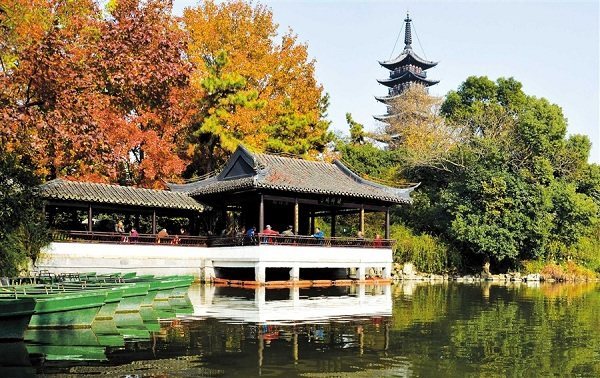Old and new meld in a charming garden setting
 0 Comment(s)
0 Comment(s) Print
Print E-mail Shanghai Daily, February 22, 2017
E-mail Shanghai Daily, February 22, 2017
|
|
|
The crystal-clear Riyue River, or Sun-Moon River, is named after two waterways of ancient Songjiang. (Photo/Shanghai Daily) |
Old and new, East meets West. Fangta Park in the eastern corner of the former Old Songjiang in southwest Shanghai has melded disparate elements into a delightful site that might better be called an open-air museum.
The park hosts the namesake Fangta, a rectangular tower built in the Song Dynasty (960-1279), a zhaobi, or screen wall from the Ming Dynasty (1368-1644), the Tianfei Palace dating back to the Qing Dynasty (1644-1911), and centuries-old plants.
"It's interesting to note that there was no park here some 30 years ago," says park official Yu Jie. "It was built to protect the old architectural relics and offer local residents a tranquil place to spend some time."
Indeed, three decades ago, the area was awash with rubble and overgrown with weeds. The dilapidated tower, ancient stone bridges, old dried-up wells and scraggly vegetation did little to make the place inviting.
Then Feng Zishong (1915-2009), an architect and professor at Tongji University, was invited to design a park that would preserve the cultural relics and integrate with the while surrounding landscape.
Feng set up several whitewash brick walls in the south and east, echoing with the ancient zhaobi in the north. His design separated the park into different spaces — a big lawn, a central square and a lake — with the tower as its centerpiece. The various spaces were linked with meandering paths.
Walking into the park, visitors are often surprised to find openness and a wide vista -— elements not associated with the delicate, complicated designs of traditional Chinese gardens.
The path from the northern gate to the tower is flanked by lush green trees. The short journey onward becomes an inviting prelude to arrival at the tower when it suddenly pops into view.
The elevation of the walkway was specifically designed to be lower than the tower's terrace, "making visitors admire the tower as if they were looking at a precious item exhibited in a museum," Feng wrote in his work log.
Though constructed during the Song Dynasty, the tower really exemplifies the architecture of the earlier Tang Dynasty (AD 618-907), with its grand and imposing style. The tower has nine stories, rising to 42.65 meters. Technically speaking, Song Dynasty towers were usually hexagons, but this tower follows the oblong Tang style.
If you look closely, you can see carvings on the ancient doors and pillars. Many of the roof tiles are originals. The brick-and-wood tower is considered one of the best remaining examples of the ancient ornamentation and architecture of southern China.
Bronze bells at the four tips of the tower have been tolling for more than 900 years. The bells are called jingniao, or alarming birds, because they were originally designed to keep birds from nesting on the roof.







Go to Forum >>0 Comment(s)